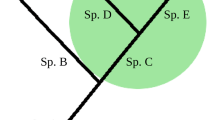Abstract
Antibodies raised against the glycine decarboxylase proteins P1, P2, P3, and the selenoprotein PA, a component of the glycine reductase complex, were used for immunocytochemical localization experiments. Cells of Eubacterium acidaminophilum from logarithmic growth phase were fixed in the growth media with paraformaldehyde and glutaraldehyde. Fixed cells were embedded by the low-temperature procedure using Lowicryl K4M resin, and the protein A-gold technique was applied for the localization experiments. The vicinity of the cytoplasmic membrane contained about 27% of all gold particles when proteins P1 and P2 were to be localized, 50% for protein PA, and 61% for protein P3. Double immunocytochemical labeling experiments gave evidence for the existence of a protein P1/P2 complex located predominantly in the cytoplasm, and a P3/PA complex located at the cytoplasmic membrane. Only in very few instances the labels for proteins P3 and P1 were seen very close together in respective doublelabeling experiments. These results indicate that glycine decarboxylase does not occur in this organism as a complex consisting of all four proteins, but that protein P3, the atypical lipoamide dehydrogenase, takes part in both the glycine decarboxylase as well as in the glycine reductase reaction.
Similar content being viewed by others
References
Bendayan M (1982) Double immunocytochemical labeling applying the protein A-gold technique. J Histochem Cytochem 30: 81–85
Bourguignon J, Neuburger M, Douce R (1988) Resolution and characterization of the glycine-cleavage reaction in pea leaf mitochondria. Properties of the forward reaction catalysed by glycine decarboxylase and serine hydroxymethyltransferase. Biochem J 255:169–178
Cone YE, Martin Del Rio R, Stadtman TC (1977) Clostridial glycine reductase complex. Purification and characterization of the selenoprotein component. J Biol Chem 252:5337–5344
Freudenberg W, Andreesen JR (1989) Purification and partial characterization of the glycine decarboxylase multienzyme complex from Eubacterium acidaminophilum. J Bacteriol 171:2209–2215
Freudenberg W, Dietrichs D, Lebertz H, Andreesen JR (1989) Isolation of an atypically small lipoamide dehydrogenase involved in the glycine decarboxylase complex from Eubacterium acidaminophilum. J Bacteriol 171:1346–1354
Hiraga K, Kikuchi G (1980) The mitochondrial glycine cleavage system. Purification and properties of glycine decarboxylase from chicken liver mitochondria. J Biol Chem 255:11664–11670
Kikuchi G, Hiraga K (1982) The mitochondrial glycine cleavage system. Unique features of the glycine decarboxylation. Mol Cell Biochem 45:137–149
Klein SM, Sagers RD (1966) Glycine metabolism. I. Properties of the system catalyzing the exchange of bicarbonate with the carboxyl-group of glycine in Peptococcus glycinophilus. J Biol Chem 241:197–205
Klein SM, Sagers RD (1967) Glycine metabolism. III. A flavinlinked dehydrogenase associated with the glycine cleavage system in Peptococcus glycinophilus. J Biol Chem 242:297–300
Kochi H, Kikuchi G (1974) Mechanism of the reversible glycine cleavage reaction in Arthrobacter globiformis. I. Purification and function of the protein components required for the reaction. J Biochem 85:1113–1127
Kohring GW, Mayer F, Mayer H (1985) Immunoelectron microscopic localization of the restriction endonuclease EcoRI in Escherichia coli BS5. Eur J Cell Biol 37:1–6
Motokawa Y, Kikuchi G (1971) Glycine metabolism in rat liver mitochondria. V. Intramitochondrial localization of the reversible glycine cleavage system and serine hydroxymethyltransferase. Arch Biochem Biophys 146:461–466
Ossmer R, Mund T, Hartzell PL, Kohnheiser U, Kohring GW, Klein A, Wolfe RS, Gottschalk G, Mayer F (1986) Immunocytochemical localization of component C of the methylreductase system in Methanococcus voltae and Methanobacterium thermoautotrophicum. Proc Natl Acad Sci USA 83:5789–5792
Rieth M (1987) Untersuchungen zur selenabhängigen Glycinreduktase aus Eubacterium acidaminophilum. PhD thesis, Univ Göttingen
Rohde M, Mayer F, Meyer O (1984) Immunocytochemical localization of carbon monoxide oxidase in Pseudomonas carboxydovorans. The enzyme is attached to the inner aspect of the cytoplasmic membrane. J Biol Chem 259:14788–14792
Roth J, Bendayan M, Orci L (1978) Ultrastructural localization of intracellular antigens by the use of protein A-gold complex. J Histochem Cytochem 26:1074–1081
Roth J, Bendayan M, Carlemalm E, Villiger W, Garavito M (1981) Enhancement of structural preservation and immunocytochemical staining in low temperature embedded pancreatic tissue. J Histochem Cytochem 29:663–669
Seto B (1980) The Stickland reaction. In: Knowles CJ (ed) Diversity of bacterial respiratory systems, vol. II. CRC Press, Boca Raton, pp 49–64
Slot JW, Geuze HJ (1985) A new method of preparing gold probes for multiple-labeling cytochemistry. Eur J Cell Biol 38:87–93
Stadtman TC (1962) Studies on the enzymic reduction of amino acids. V. Coupling of a DPNH-generating system to glycine reduction. Arch Biochem Biophys 99:36–44
Stadtman TC (1965) Electron transport proteins of Clostridium sticklandii. In: Pietro AS (ed) Non heme-iron proteins: Role in energy conversion. Antioch Press, Yellow Springs, Ohio, pp 439–445
Stadtman TC (1970) Glycine reductase system (Clostridium). Meth Enzymol 17A:959–966
Tanaka H, Stadtman TC (1979) Selenium-dependent clostridial glycine reductase. Purification and characterization of two membrane associated protein components. J Biol Chem 254:447–452
Walker JL, Oliver DJ (1986) Glycine decarboxylase multienzyme complex. Purification and partial characterization from pea leaf mitochondria. J Biol Chem 261:2214–2221
Zindel U, Freudenberg W, Rieth M, Andreesen JR, Schnell J, Widdel F (1988) Eubacterium acidaminophilum sp. nov., a versatile amino acid-degrading anaerobe producing or utilizing H2 or formate. Description and enzymatic studies. Arch Microbiol 150:254–266
Author information
Authors and Affiliations
Rights and permissions
About this article
Cite this article
Freudenberg, W., Mayer, F. & Andreesen, J.R. Immunocytochemical localization of proteins P1, P2, P3 of glycine decarboxylase and of the selenoprotein PA of glycine reductase, all involved in anaerobic glycine metabolism of Eubacterium acidaminophilum . Arch. Microbiol. 152, 182–188 (1989). https://doi.org/10.1007/BF00456099
Received:
Accepted:
Issue Date:
DOI: https://doi.org/10.1007/BF00456099




